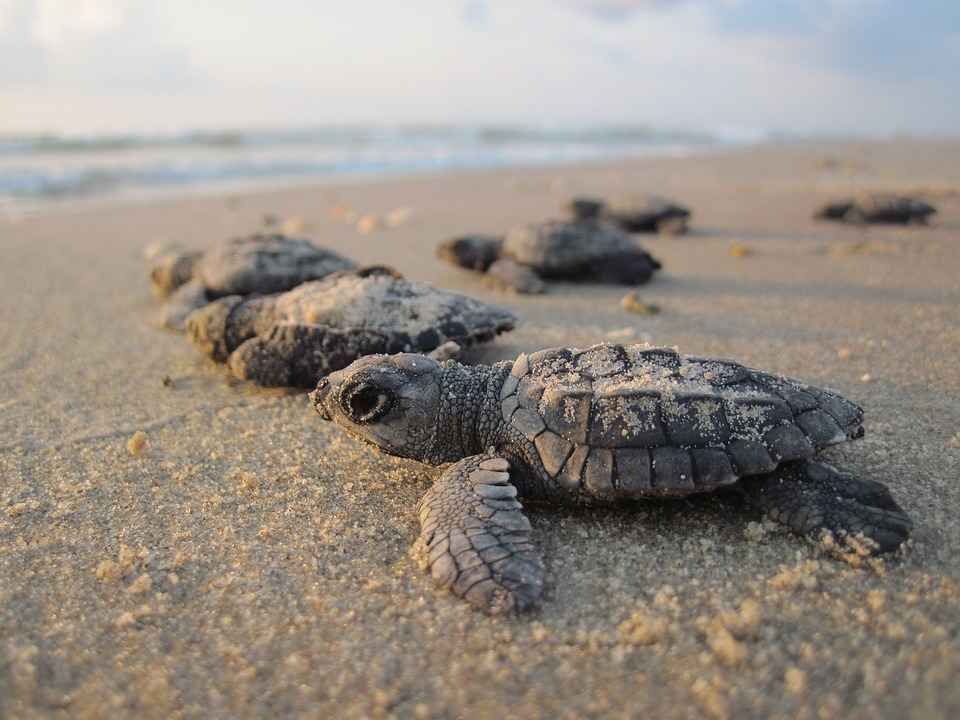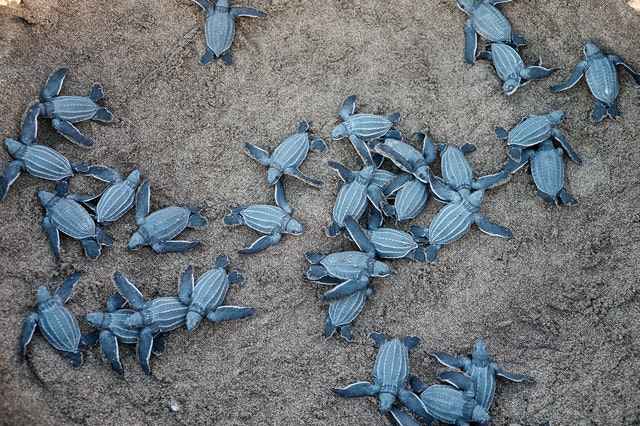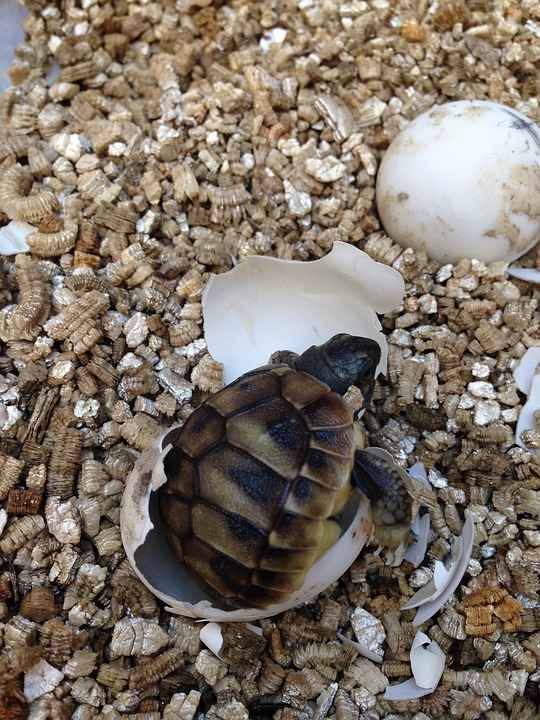 If you want to have a turtle as a pet or you just love reading about turtles, you have to read this guide.
If you want to have a turtle as a pet or you just love reading about turtles, you have to read this guide.
You’ll find all knowledge about turtles and their babies here in this guide. I did serious research and put together the real baby turtle guide.
How Many Babies do Turtles Have?
Depending on species, turtles can lay between 3-200 eggs in one nest. Most of the Eggs won’t hatch and survive so Turtles usually have 1-10 surviving babies.
Pet turtles lay 15 eggs in a nest on average. Only 10-20% of these eggs will hatch, and 1 in 1000 hatchlings will survive in nature. Many species nest a few times a season, so they’ll have a higher chance of surviving.
There are many interesting things about turtles. How they lay eggs, how they protect their eggs and how many of them will actually survive. All of those questions have really interesting and unexpected answers.
How Many Eggs do Turtles Lay
This very much depends on the species of turtles. Some turtles may lay 5 eggs and others may lay even 200 eggs in one nest.
If turtle lays that many eggs, it means very few of those eggs are going to hatch, and even fewer hatchlings will survive after they are born. I will cover “the most popular” turtles and their babies here:
Pet turtles
There are many sorts of pet turtles. They usually lay between 3 and 30 eggs in one nest. Oftentimes pet turtles are box turtles or red-eared sliders. Pet turtle will have on average 1, 2, or no survived babies after hatching in the wild. If you take good care of them, most babies will survive.

Sea turtles
Sea turtles will generally lay more than one nest per season. Usually from 2 to 8 nests. There will be 110 eggs on average in one nest. The smallest nest would be around 50 eggs, and the largest nests would be over 200 eggs in one nest.
The largest nest ever recorded for a sea turtle is 238 eggs. From the average 110 eggs per nest, only 10% will hatch, that means 11 babies from a nest.
Reaching adulthood will be nearly impossible for every egg that is hatched because only 1 in 1000 sea turtles will reach adulthood. That means an average sea turtle will have to nest 9-10 times, to see her baby reach adulthood.
After a sea turtle nests, she’ll go back to the sea leaving her nest camouflaged. She has to camouflage them because her eggs are a target to many predators. When sea turtles hatch, they rush to the sea.
They’ll eat seaweed, jellyfish and fish eggs. To find the ocean, hatchlings use light direction, the sun reflects from the ocean hence they follow the light. They can mistake car lights or street lights and can go in the wrong direction.
Box turtles
The normal nest size of a box turtle is between 3-9 eggs. They can nest many times per season. In the more northern population , box turtles nest size is often bigger. Most of the eggs from box turtles won’t make it.
Many predators are trying to eat them. Some of them are snakes, insects, fire ants, humans, cats, and dogs. I mentioned humans because box turtles are endangered from collection for the pet trade. Humans are also damaging their habitats.
Many box turtles die on roads, getting crushed by cars. Herbicides and pesticides also have a role in the destruction of box turtle species. Some of the turtles who survive this can live up to 100 years.
Red eared sliders
Depending on body size and other factors, red-eared sliders can lay from 10-30 eggs in one nest. Females can lay up to five nests per season.
Like most of turtles, red-eared sliders lay many eggs, but few of them will hatch, and even fewer will survive to grow up. They are often being used as pets.
That is why all risk factors to their eggs are more or less the same as ones for box turtles. Cats, dogs, snakes, insects damaging their nests, humans trying to trade them.
Snapping turtles
Snapping turtles usually build their nests around April, in spring and summer. They will lay between 20-40 eggs in one nest. Perfect places for nests are sandy beaches and dry areas. Snapping turtles will dig nests, lay eggs, then will cover them up and go back to a lake.
To increase the chance of survival, some snapping turtles can lay up to 100 eggs in a single nest. Nests are often damaged by predators. Predators will destroy almost 80% of eggs.
The remaining eggs will hatch, and they will again be vulnerable to predators. Those that survive and reach adulthood will have almost no predators. They can then live up to 30-40 years.
Turtles can even lay eggs without mating. Most of them will start laying eggs from 3 to 5 years old. No matter if they haven’t mated. These eggs won’t be fertile and babies won’t come out of it.
Turtles can also mate once, and then lay eggs years after that. Some species can lay eggs even three years after mating.

How & Where Do Turtles Lay Eggs
Mating activity for turtles begins in spring and summer. The perfect water temperature is between 50-77 degrees. Sea turtles mate in water, just offshore. The male will stroke the female’s neck and face with front claws, and if she returns the gesture, she’s ready to mate. Terrestrial turtles mate on land.
Their ritual is much rougher, the male will bite the female, they may bump shells. Three to six weeks after mating, turtles will lay their first eggs.
Before laying her eggs, the female will try to find the perfect place to lay her eggs. She will spend more time on land searching, smelling, and feeling the land.
She’ll try to find sandy or moist soil. Turtle can delay laying her eggs sometimes for weeks if the atmosphere temperature is not right. Turtle can also store sperm in her body, it can be stored up to three years.
The turtle will dig a nest and lay her eggs in the nest. She’ll finish nesting in a couple of hours and cover up the nest and leave her eggs.
Covering up eggs helps them maintain proper temperature, keeping the shell moist and not allowing them to dry out.
She covers up the nest with sand, then tries to camouflage it with dry sand, so predators can’t feel there is moist. Mothers are not known for their maternal side as none of them will ever see their babies.
After laying eggs the mother will leave, never see her babies. She’ll go back to her watery home, in a sea or a lake. Babies are left alone to try to survive.
How Often Do Turtles Lay Eggs
Some turtles lay eggs several times a season. Sea turtles lay their eggs 2-8 times in one year. Some will lay eggs every two or three years. Season starts in spring or summer, around April. Babies will hatch around November when season usually ends.
That means sea turtles will on average lay her eggs every six weeks. Sea turtle lay around 110 eggs in one nest.
Some turtles lay much fewer eggs, like a box turtle that lays 3-9 eggs per nest. The largest ever recorded nest was 238 eggs laid by a green turtle.
Red-eared sliders lay from 10 to 30 eggs. Snapping turtles lay from 20 to 40 eggs, but they can lay up to 100 eggs per nest.
How Are Turtles Born
When eggs are laid, incubation lasts from 45 to 75 days, depending on the temperature inside the egg. If the weather is warm eggs will hatch sooner, if the weather is cool eggs will hatch later. Surprisingly a gender of a baby turtle depends on a temperature inside the egg.
Temperature is in range of 83 to 85 degrees, at this temperature embryos develop into a mix of males and females. Hotter temperatures produce females while colder temperatures produce male turtles.
A baby opens the egg with an egg tooth, it then falls out one hour after hatching and never grow back. Baby turtles are born with a shell, but it is a lot softer in the first few days.
After they hatch, they’ll dig a sand where they are covered up, leave eggs shells on the bottom of the nest, and try to climb on the surface. If they successfully climb on the surface, they will race to the ocean.
If they survive and reach adulthood, they’ll live 50 and for some species even 100 years. About 10-15 after they are born, they mature and can start mating.
How Do You Know If A Turtle Egg Is Alive
There are more ways to tell if a turtle egg is alive, but neither of them is 100 percent accurate. When examining an egg, one has to be very gentle because turtle eggs are very fragile.
If an egg is becoming closer to hatch, eggshell will be thinner and weaker. When a turtle lays eggs, the shell is pink-white color. As embryo develops shell becomes darker white color.
If the egg is not alive, the shell wouldn’t change color. The texture of the shell will change during this process. You can feel it in your hand, over time shell will become harder to touch.
If an egg isn’t alive texture of the shell won’t change. The last method is the flashlight method. This is done in the night or in a dark room. Put the flashlight under the egg, if you see a turtle embryo it means the egg is alive.
If you don’t see an embryo, wait one week then repeat this method. The development of turtle eggs is very slow.

Related Questions
How long does it take turtles to lay eggs? Turtle usually lays her eggs when it’s colder, during the night. She’ll start digging several holes, and may abandon them to try to dig again tomorrow night.
She’ll dig with her front and back legs, and use back legs to position the eggs after they are laid. After laying all eggs, turtle will cover up the nest for several hours.
The whole process of laying eggs takes half a night, and she’ll return home, to her pond, lake, or a sea, the same night.
How long does it take turtle eggs to hatch? The eggs will be incubated for 2-3 months, approximately 60 days. After hatching babies will remain in their nest until they absorb yolk form the eggs.
When they absorb yolk, hatchling will dig to surface and find their way to the ocean. The whole process will be over in 45-90 days. When hatching starts, it can take several days or weeks for all eggs to hatch.
Can Turtle Eggs Be Moved? Turtle eggs have a very low chance to survive. As I said earlier 1 in 1000 turtles will reach adulthood. Turtle eggs can be found in very unexpected places.
The mother will try to hide eggs from predators, and will search for a place to make a nest. Eggs can be moved, no matter what natural habitat looks like, but with a very low chance of survival. In some regions you need to authorize it with EPA (Environmental Protection Agency).
Some eggs will not develop if they are not oriented properly after being moved. Eggs that are being moved have to be put in the same direction. The top of the egg always has to face up. Turtles can feel Earth’s magnetic field and will know where the ocean is.






